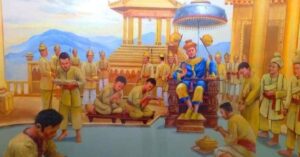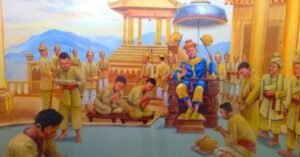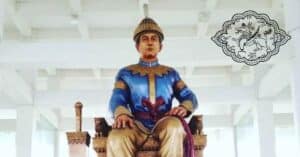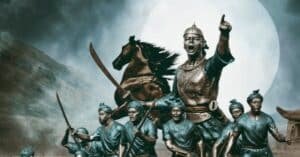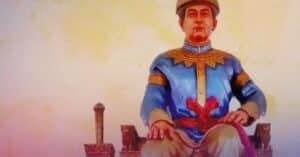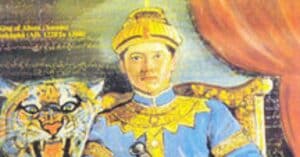The rule of numerous Ahom Kings glorifies the history of Assam. The Ahom dynasty ruled Assam from 1228 AD to 1826 AD. Six decades of Ahom rule is one of the brightest periods of Assam’s history. A successive generation of Ahom kings defeated numerous hill tribes and Mughal invaders to make Assam a powerful state. Besides, the generations of Ahom kings contributed economic and cultural development of Assam. Here is the selected list of Ahom King (Part 1):
Sukapha: The First Ahom King
The Ahom kings were of the Tai race and their original inhabitation was the Shan area of present-day Myanmar. Sukaphaa, along with his group, left Mong Mao(Myanmar) in 1215 and arrived at Namrup (Assam) through Patkai Hills on December 02, 1228. Over the next few years, he moved from place to place searching for the right capital. They had a long stay at Habung(Dhemaji district of Assam), living by cultivation but the floods forced them to abandon it in 1242. Later they stayed at Simaluguri, abandoning it in 1252 for Charaideo where Sukapha built a capital city on the hill. Sukapha was the first Ahom king who ruled from 1228 CE to 1268 CE
He subjugated two immediate neighbours – the Moran tribe and the Barahi tribe. He fought and defeated these tribes, after which he wisely adopted conciliation. He treated them as equals and encouraged intermarriage. As was the practice in his native land, Sukapha appointed chief officers of state, namely Bar Gohain and Burha Gohain, who wielded power next only to the king.
Sutenpha / Suteuphaa
Suteuphaa was the second king of Ahom kingdom who ruled from 1268 CE to 1281 CE. He annexed the area east of the Dikhou River ruled by the Kachari tribe. Read this blog to know how he tricked the Kachari tribe into claiming territory.
Sukhangpha
Suteuphaa was the fourth king of Ahom kingdom who ruled from 1293 CE to 1332 CE. Under the leadership of Sukhangpha, the Ahoms successfully stood their ground against petty tribal chiefs in the vicinity. Later on, they became strong enough to challenge the more powerful but distant Kamata. After years of hostilities, the Kamata king, Pratapdhvaj, sued for peace. A treaty was made and he gave his daughter Rajani, in marriage to the Ahom king.
Sukhrangpha
Suteuphaa was the fifth Ahom king who ruled from 1332 CE to 1364 CE. The reign of Sukhrangpha is significant for the revolt by Chao Pulai and Chaopang Banduk Borgohain (One of three Chief Ministers of the Ahom dynasty). They hatched a plot against the king which failed. Chao Pulai, being the son of Kamata princess Rajani, fled to the Kamata kingdom. The Kamata ruler marched on the Ahom king. Sukhrangpha, therefore, avoided confrontation and reconciled with Chao Pulai. He appointed Chao Pula as the Charing Raja.
Tao Khamti
Tao Khampti was the seventh Ahom king who ruled from 1332 CE to 1364 CE. His ascension to the throne marked the conclusion of the interregnum in the Ahom kingdom, spanning from 1376 CE to 1380 CE, following the treacherous murder of King Sutuphaa by the Chutia king.
One of his important acts as King was to lead his army to avenge his brother’s murder. During his absence, the Elder Queen, and the Regent, got the Younger Queen, the king’s favourite, sentenced to death on concocted charges. Finding her pregnant, the nobles refused to behead her and instead, she was set adrift on the Brahmaputra on a raft. At Habung, she was rescued by a Brahmin but she died after giving birth to a baby boy, named Sudang. The child was then brought up by the Brahmin.
Returning from victory, he proved helpless to take action against his wilful wife; nor could he protect his subject from her Oppression. His incapacity as a king angered the nobles so much so that they had him assassinated in 1389. The notorious elder queen was also put to death and was entombed along with the king in Charaideo Maidam.
Sudangphaa (Bamuni Konwar)
Sudangphaa was the eighth Ahom king who ruled from 1397 CE to 1407 CE. He was known as Bamuni Konwar as he was brought up by a Brahmin. Among the successors of Sukapha, Sudangpha was one of the very active and energetic ahom kings. He achieved victory in four battles and at least in one he led his army.
Because of the peculiar circumstances of his accession, his reign marks the first stage of Hindu influence among the Ahoms. He made his capital a colony of the Brahmins and converted his tribal court into a centre of Hindu culture. It was during his reign indeed that seeds of Hinduism were sown in the Ahom kingdom.
Sudangpha was the first Ahom king to mint coins and build a new capital at Charguwa near the Dihing River in 1403 CE. He assumed the grandiose titles of ‘Maharaja’ and ‘Rajesvar Chakravarty’. His predecessors ruled a little territory till he came on the scene in 1397 and expanded his domain after fighting battles with the Tipam chiefs, Surumpha- the ruler of Mongkawng (called Nara in Ahom chronicles), Kamata king and the Nagas.
Susenpha
Susenpha was the eleventh Ahom king who ruled from 1439 CE to 1488 CE. He ruled for almost 49 years. His reign was one of the peaceful periods of the Ahom dynasty except for the Ahom expedition against Tangsu Nagas. The most important event of his reign was the birth of Sankardeva, the great Vaishnavite saint in 1449.
Suhungmung (Dihingia Roja)
Suhungmung was the fourteenth Ahom king who ruled from 1497 CE to 1539 CE. He was popularly known as Dihingia Raja because he shifted the capital to Bakata on the banks of Dihing. He assumed the title of Swarga Narayana (=lord of heaven), the first Ahom monarch to do so, and the practice was followed by all his successors.
During his reign, Aitonia Naga rose into rebellion in 1504 AD. The royal forces led by two Gohains suppressed the revolt. To sue for peace, the Nagas sent their Chief’s daughter to the king and a present of four elephants. They also promised a yearly tribute of axes, gongs and amber.
War with the Chutiya Kingdom
In the year 1513, the Chutiya Raja, Dhir Narayan, rose again and invaded the Ahoms. With an army (mainly foot) and a flotilla of boats, he lost the battle at Siratee. Suhungmung captured Mungkhrang and the country around Namdang where he built a town.
After preparing for some years, the Chutiyas re-captured the Ahom fort at Mungkhrang in 1520. Suhungmung again defeated them. After a series of battles, the Chutiya kingdom was annexed in 1523 and a new officer of the state designated Sadiya Khowa Gohain (=Governor of Sadiya) was appointed to administer its erstwhile territory.
Third (Barpatra) Gohain Created
The pregnant wife of Supimpha was sent to a Naga chief in a huff and subsequently gave birth to a son. Singularly struck by his highbred appearance and learning of the relevant facts, the King took the youth in his favour, created a new office of Barpatra Gohain for him, and equated it with Bar and Burha Gohains. The latter two refused to cede any part of their jurisdictions to the new office; the King resolved the issue by allotting to him the territories peopled by the Borahis, Chutiyas, and the Morans not yet placed under either of the two.
The Kachari War
The king marched against the Kacharis, ascending the Dhansuri to Barduar, where he got a bathing ghat constructed for common use; then proceeded to Marangi where he erected a brick-walled fort; and finally reached Maiham (or Kathkatia). The defenders fought bravely with bows and arrows but had to retreat with huge losses, leaving 1700 dead on the field.
Muhammadan Invasion: 1527 AD
Led by a great Wazir of Bengal ruler, it was the first Muslim invasion against the Ahoms. They were defeated and pursued right up to the Burai River. In 1531-32 AD, the Muslims invaded again. The Muslims advanced up the Brahmaputra with 50 vessels. Barbara Gohain repelled the forces and pursued the enemy right up to Khagariajan (present Nagaon), capturing 50 horses, several cannons and guns. A delighted Suhungmung presented him with a beautiful girl and ordered a rikkhovan ceremony for him.
In April 1531, a large force under Turbak invaded the country. This time also, the invading army was defeated comprehensively. The Ahoms chased the Muslims right up to the Karatoya where in commemoration of the victory they erected a temple and dug a tank.
Ties with Koch and Manipur Kings
The Koch King Biswa Singh and his brother visited the Ahom Raja and offered presents, and also received them in return. They were escorted back to the frontiers by a guard of honour. The envoys were also sent to the Manipur kings and were exchanged.
Suhungmung Assassinated
The King’s relations with his son, Suklen were strained. Suklen suborned the Kachari servant of the king, Ratiman, and the latter stabbed the king to death in sleep.15
An assessment of King Suhungmung
It was a tragic end to a very successful 42-year reign of one of the most outstanding Ahom kings. Bold and resourceful, he was the only one to expand the Ahom kingdom in the 15th century in all directions after Sudangpha, who had ascended the throne exactly a hundred years ago in 1397. The Chutiya kingdom was annexed, the Nagas chastised, and the Kachari power broken with their capital occupied twice. He fought the powerful Nara king (Phukliamung) and repulsed three Muslim invasions led by: Bar Vazir (=Great Minister) of Bengal ruler; Luput; and finally Turbak. The use of firearms was introduced during his reign. Besides the growing influence of Hinduism, the nation also witnessed the spread of the Vaishnava reformation espoused by Sankar Dev. The old system of calculating dates by the Jovian cycle of 60 years was replaced by the Hindu Saka Era.
Suklengmung (Garhgaya Roja)
Suklengmung was the fifteenth Ahom king who ruled from 1539 CE to 1552 CE. Since he established his capital at Garhgaon, he is also called the Garhgaiya roja in the history of Assam. During his reign, the Koch kingdom under the leadership of Nar Narayan (1540-81) had emerged as the most powerful kingdom, essentially because of the military exploits of his redoubtable brother, Sukladhvaj alias Chila Rai. The Koch Army under Chila Rai marched against the Ahoms in 1546 and won many battles at Dikrai River, Koliabar and Sala. Suklenmung was able to regain the whole of his lost territory.
Assessment of King Suklenmung
His major achievement was his victory over the forces of Koch King Nar Narayan under the redoubtable Chila Rai. He was the first Ahom king to strike coins, an innovation that can be ascribed to the greater interaction with the advanced regimes to the west of Assam. His major achievement with great socio-economic significance was the construction of the Naga Ali (=Naga Road) which ran through the Gadhuli Bazar Mauza from Bar Ali to the Naga Hills.
Sukhampha (Khora Roja)
Sukhampha was the seventeenth Ahom king who ruled from 1552 CE to 1603 CE. He had many achievements to his credit. To befriend the Naras, he made a matrimonial alliance with the Nara king, Chau-Sui-Kwei. He subdued the Bhuiyas and the Nagas and fought and ultimately succeeded in repulsing the Koches from Ahom land. Entering the matrimonial relationship with Raghu Deb, the Koch king of the Eastern branch, he played an important role in their affairs and sided with them against their rivals of the Western branch.
Pratap Singha (Susenghphaa)
Sukhampha was the seventeenth Ahom king who ruled from 1545 CE to 1641 CE. His reign was marked by his conflicts with the Kachari and Jaintia Rajas and the Mughal invasion of Assam. He created two new posts of ahom royalty- Borphukan (Governor of conquered provinces west of Koliabar) and Borbarua (Governor of conquered provinces east of Koliabar).
Ahom-Kachari-Jaintia Raja Conflict
Jasa Manik, the Jaintia ruler, tricked the Ahom king into fighting the Kacharis by promising him his daughter’s hand in marriage if he could bring her through Kachari territory. The Ahom troops succeeded in bringing the princess to the king but were later driven out by the Kacharis, resulting in the death of Sundar Gohain, an Ahom prince and commander. To avoid conflict with the Mughals, the Ahom king reconciled with the Kacharis by offering one of his princesses to marry the Kachari ruler.
Mughal Invasion of Ahom Kingdom
In 1615, Bali Narayan, brother of Parikshit (Koch king) whom the Mughals had just defeated, was given shelter by Pratap Singh. Sheikh Qasim, Bengal Governor, sent a punitive force of 10,000 horses and foot and 400 ships against the Ahoms under Sayyed Hakim and Sayyed Abu Baqr. The Mughal force under them suffered a major disaster near Koliabar. The Ahom king made Bali Narayan tributary Raja of Darrang (that is, Eastern Koch Kingdom), with the title of Dharma Narayan.
After a lull of a few years, the hostilities erupted again between the Ahoms and Mughals. Both sides could not gain significant advances to their early position.
Treaty of Asurar Ali (1639)
The Treaty of Asurar Ali (early February 1639) was signed between the Mughal General Allah Yar Khan and the Ahom General Momai Tamuli Borbarua (under Ahom King Pratap Singha). Under a Peace Treaty, Bar Nadi on the one of Brahmaputra and Asurar Ali on its south were fixed as boundaries between the Ahom and Mughal territories. For the next 20 years, the country west of Bar Nadi remained under the Mughals and traces of the administrative system introduced by them survived the British rule there.
An Assessment of Ahom King Pratap Singha
Pratap Singh was one of the greatest among the Ahom Kings. A capable and ambitious Prince whose 38-year rule was distracted by wars with the Kacharis and Mughals but he still managed to devote a lot of time and attention to improving the internal organisation of his kingdom and to caring for the welfare of his people. One of his major achievements was to break the power of the Bhuiyas who occupied the tract on the north bank of the Brahmaputra between the Bharali and Subansiri rivers, by transporting them and their supporters to various places south of the river during 1624-25 AD.
To check the depredations of his tribal neighbours, a defensive embankment, known as Dopgarh, was thrown up against the Naga raids, no Naga being permitted to cross it unless accompanied by a Kataki (a frontier guard or official); a defensive embankment, Ladaigarh, was thrown round Garhgaon; and Katakis was appointed to keep an eye upon acts of aggression by Muris and Daflas.
Some of his other achievements were: a census was conducted, towns of Abhoypur and Mathurapur were built; the day he bagged his one-thousandth elephant, always an eager desire, he assumed the title of Gajapati (Lord of the Elephants); and when the construction of Misagarh was completed, Brahmins were called in to consecrate it.
Sukhaamphaa (Khora Roja)
Sukhampha was the eighteenth Ahom king who ruled from 1641 CE to 1644 CE. His ignominious expulsion of Kachari envoys who came to offer their king’s greetings on his accession caused a needless worsening of Ahom-Kachari relations.
For his immoral conduct and cruel and queer treatment of his nobles, he was deposed and poisoned to death. Consequently, he earned the sobriquet of Bhaga (or Bhagaya, ie deposed) Raja because of this deposition. Another view is that he was called so because he once fled (ran away bhaga) the battle showing cowardice.
Sutingphaa (Noriya Roja)
Sutingphaa was the nineteenth Ahom king who ruled from 1644 CE to 1648 CE. He was known as “Noriya” (sick) Raja, because of his poor health, he was also called Kekora (crooked) Raja for he suffered from the curvature of the spine. The major achievement of his reign was the Dafla Expeditions. Tipam Raja was put to death for his failure to pay the tribute. A punitive expedition was also sent against the Khamptis. Sutingphaa also met the fate of his predecessor, deposed by the nobles in November 1648 and later poisoned to death. His son succeeded him.
Jayadhwaj Singha (Sutamla)
Jayadhwaj Singha was the 2oth Ahom king who ruled from 1648 CE to 1663 CE. During his reign, the Mughal viceroy at Bengal, Mir Jumla invaded and occupied his capital Garhgaon as a result of which he had to retreat to the Namrup area. Because of this flight, he is also known as the Bhagania Roja in the Buranjis. In the days of Jayadhwaj Singha Auniati Satra and Dakhinpat Satra (two prominent satras of Majuli) were established.
Assessment of Ahom King Jayadhvaj Singh
The Ahom kingdom was obviously on its downhill course, for the time being. He failed to check the advance of the Mughals and ended up ceding his western dominions to them. The king had come under the influence of Hinduism and enrolled himself as a disciple of Niranjan Bapu, whom he established as the first Gosain of the great Auniati Satra. He was thought to have committed cruelties on his nobles, forcing one to eat the flesh of his son.
Chakradhwaj Singha
Chakradhwaj Singha was the 2oth Ahom king who ruled from 1663 CE to 1670 CE. To regain an autonomous status and free Guwahati from the Mughals, he sent an army on 20 August 1667 under Lachit Borphukan. The Ahoms took back Guwahati from the Mughals during the famous Saraighat Battle. Reinforcements sent from Dacca in November 1667 failed to recapture Gauhati. Furious at the impudence of a mere vassal, Aurangzeb despatched a fresh army under his able, trusted General Ram Singh of Amber, but to no avail.
Read This Blog For Part 2 of the Selected List of Ahom King With Details
FAQs Regarding Ahom Kings
Q: Who was the first Ahom King?
A: Sukapha established the Ahom dynasty in Assam and was the first king of the Ahom dynasty.
Q: How many years did Sukapha rule?
A: Sukapha ruled from 1228 AD to 1268 AD.
Q: Which was the first capital of the Ahom dynasty?
A: Charaideo was the first capital of the Ahom dynasty and it was established by Sukapha in 1253 AD.
Q: When is Sukapha Diwas or Assam Diwas celebrated?
A: It is celebrated on December 02.
Q: Why Sukapha Diwas or Assam Diwas is celebrated on December 02?
A: December 02 is considered the date on which Sukapha, the first Ahom king arrived in Assam.
Q: Who was the Ahom king who first married the princess of the Kamata kingdom?
Q: Suteuphaa, the third king of the Ahom dynasty, married Rajani, the daughter of Kamata King Pratapdhvaj.
Q: Which Ahom King was known as Bamuni Konwar?
A: Sudangphaa was known as Bamuni Konwar as he was brought up by a Brahmin.
Q: Which Ahom King introduced Hindu religious rituals in the Ahom court?
A: Sudangphaa known as Bamuni Konwar introduced many Hindu rites and ceremonies that began to be observed in Ahom court.
Q: Which Ahom King established the tradition of ‘Singari Ghar Utha’?
A: The tradition of ‘Singari Ghar Utha’ was established by Sudangphaa. Sudangpha built a new capital at Charguwa near the Dihing River in 1403. The tradition of ‘Singari Ghar Utha’ was performed to inaugurate the new capital ceremoniously. It was called so because the main platform of the king’s seat was built by a Singari tree.
Q: Who was the Ahom king when Sankardeva was born?
A: Susenpha, the eleventh Ahom king who ruled from 1439 CE to 1488 CE, was the Ahom king during the birth of Sankardeva.
Q: Which Ahom king adopted the Hindu title of ‘Swarga Narayana’ for the first time?
A: Suhungmung (Dihingia Roja) assumed the title of Swarga Narayana (=lord of the heaven) and he was the first Ahom king to do so.
Q: Why Suhungmung was popularly known as Dihingia Roja?
A: Suhungmung shifted the capital of the Ahom kingdom from Chargua to Bakata on the banks of Dihing.
Q: Which Ahom king introduced firearms?
A: Suhungmung introduced firearms and cannons in the Ahom kingdom.
Q: Which Ahom king is known as Garhgaya Roja and why?
A: Suhungmung, the fifteenth Ahom king who ruled from 1539 CE to 1552 CE, is also called the Garhgaiya roja since he established his capital at Garhgaon.
Q: Which Ahom King created the title ‘Borbarua’?
A: Pratap Singha (Susenghphaa) created the title Borbarua.
Q: Who was the first Borbarua in the Ahom Kingdom?
A: Momai Tamuli Borbarua was the first Borbarua during Ahom rule.
Q: Which Ahom King created the title ‘Borphukan’?
A: Pratap Singha (Susenghphaa) created the title Borphukan.
Q: Who was the first Borphukan in the Ahom Kingdom?
A: Langi Panisiya was the first Borphukan during Ahom rule.
Q: Under whose reign, Asurar Ali Treaty was signed?
A: The Treaty of Asurar Ali (1639) was signed between the Mughal General Allah Yar Khan and the Ahom General Momai Tamuli Borbarua during the reign of the Ahom king Pratap Singha.
Q: Which Ahom king was known as Bhaga Roja and why?
A: Sukhampha was known as Bhaga Roja because he was deposed by his ministers i.e. he was forced to relinquish the throne.
Q: Which Ahom King was known as Bhogonia Roja?
A: Jayadhwaj Singha was known as Bhogonia roja as he fled his capital Garhgaon during the invasion of Mir Jumla.


